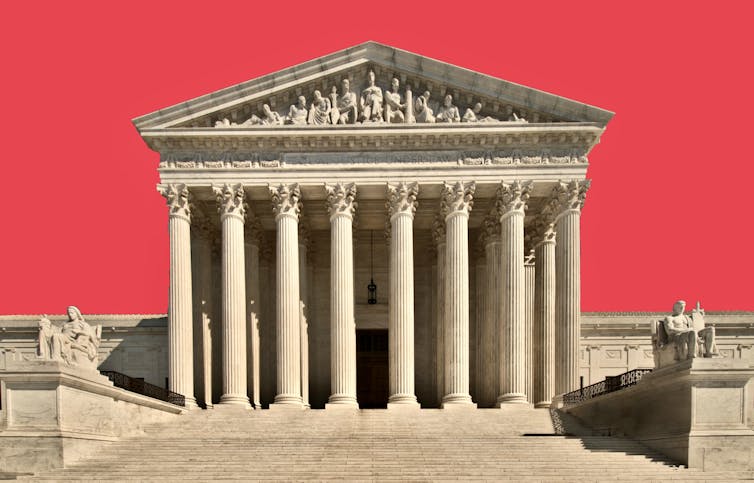
The first Monday in October, the traditional date for the beginning of the U.S. Supreme Court’s term, is almost here: On Oct. 2, 2023, the court will meet after the summer recess, with the biggest case of the term focused on the limits of individual gun rights.
The other core issue for the coming year is a broad reassessment of the power of the administrative state.
Both issues reflect a court that has announced revolutionary changes in doctrine and must now grapple with how far the new principles will reach.
Two years ago, the court began what many consider to be a constitutional revolution.
The new supermajority of six conservative justices rapidly introduced new doctrines across a range of controversies including abortion, guns, religion and race.
When the court announces a new principle – for example, a limit on the powers of a specific part of government – citizens and lawyers are not sure of the full ramifications of the new rule. How far will it go? What other areas of law will come under the same umbrella?
In a revolutionary period, aggressive litigants will push the boundaries of the new doctrine, attempting to stretch it to their advantage. After a period of uncertainty, a case that defines the limits on the new rule is likely to emerge.

Focus on guns
U.S. v. Rahimi may be the limiting case for gun rights, identifying the stopping point of the recent changes in Second Amendment doctrine.
Zackey Rahimi is a convicted drug dealer and violent criminal who also had a restraining order in place after assaulting his girlfriend. The court will decide whether the federal law prohibiting the possession of firearms by someone subject to a domestic violence restraining order violates the Second Amendment.
In the 2022 case of New York Rifle & Pistol v. Bruen, the court announced a new understanding of the Second Amendment. The amendment had long been understood to recognize a limited right to bear arms. Under the Bruen ruling, the amendment instead describes an individual right to carry a gun for self-protection in most places in society, expanding its range to the level of other constitutional rights such as freedom of religion or speech, which apply in public spaces.
However, the court’s conservative justices also tend to argue that constitutional rights are balanced by responsibilities to promote a functional society, a concept known as “ordered liberty.” The practical question is how to know the proper balance between liberty and order. If the right to carry a gun can be regulated but not eradicated, limited but not eliminated, where is the line?
The court’s answer in Bruen is history – a current law does not have to match a specific historical one exactly, but it has to be similar in form and purpose. Whatever gun regulations Americans allowed during the early Republic – the critical period from around the 1780s to around the 1860s at the time of the Civil War – are allowable now, with the exception of any that would violate racial equality under the 14th Amendment.
Justice Clarence Thomas, the author of the Bruen ruling, described it this way: The government must “identify a well-established and representative historical analogue, not a historical twin.” Thomas argued in Bruen that no such historical analogue existed for the limits New York imposed, invalidating the state’s ban on concealed carry permits.
The Rahimi case will provide a critical test of this historical approach to the boundaries of constitutional rights.
Historians have presented evidence that there were widespread laws and practices during the early Republic limiting gun possession by individuals, like Rahimi, who were judged to be dangerous. However, those dangers did not include domestic violence, which was not deemed the same important concern then that it is now.
The court may consider the laws prevalent in the early Republic, which regulated those who “go armed offensively” or “to the fear and terror of any person,” to be analogous to contemporary laws restraining those under a domestic violence restraining order. If so, the ruling will likely uphold Rahimi’s conviction and limit gun rights.
On the other hand, if the court reads those historical standards as more narrow and specific than the contemporary ban on gun possession while under a restraining order, those limits will be struck down.
The power of the administrative state
The founders expected a permanent battle for power between the Congress and the presidency. What they did not anticipate was the expansion of the federal bureaucracy.
With the growth in the number, funding and power of federal agencies, including the Environmental Protection Agency, the Department of Homeland Security, the Consumer Finance Protection Bureau and many others, the debate over who controls them and how much power they wield has grown as well.
The court’s conservatives tend to see the actions of federal agencies as violating the constitutional principle of limited government. This view argues that government powers are specific and constrained, not flexible and expansive. They fear that the federal government is likely to use its vast power abusively if it is unconstrained. In this view, the expansion of the administrative state allowed an end-run around the Constitution’s limits on government power.

The constitutional question is whether bureaucrats have broad regulatory powers over economic and social questions, or only elected officials do.
Conservatives tend to think that liberals put the bureaucrats in charge because they don’t have a majority in Congress to pass the same laws.
The liberals tend to think that conservatives are blocking necessary regulations while ignoring the flexible nature of the Constitution’s provisions to adapt to the needs of modern society.
This is a core dispute between the two judicial camps.
In the last few years, the court has emphasized new doctrines limiting the power of federal agencies.
One of those doctrines is the Unitary Executive Theory, which limits the independence of administrative agencies. In this view, if the Constitution envisions executive branch agencies as controlled by voters through the selection and removal of the president, then the president must be able to control the decision-makers within those agencies.
One case before the court this term challenges the constitutionality of the Securities and Exchange Commission, or SEC, which regulates the stock market, on the grounds that the agency operates outside the boundaries set by the Constitution in several ways. One possible violation is that its judges cannot be removed by the president, violating the Unitary Executive Theory.
Another potential constitutional violation is the SEC’s practice of imposing monetary penalties without a finding by a civil jury. The court will decide if this violates the Seventh Amendment’s guarantee of a jury trial.
Another case challenges the constitutionality of the Consumer Finance Protection Bureau on the grounds that the agency’s funding mechanism – through fees charged to the Federal Reserve rather than through normal congressional appropriations – violates how the Constitution allows the government to spend money. If Congress does not control the agency’s budget, this may put the agency outside of the control of the legislative branch that created it.
Perhaps the most far-reaching case could overturn a long-standing precedent known as Chevron deference, which allows agencies to determine the meaning of disputed terms in federal laws. Overruling this precedent would strip power from administrative agencies and reallocate decisions to Congress or to courts.
In these two core areas of constitutional conflict – gun rights and administrative powers – the court will determine this term whether its revolutionary doctrines will continue to expand or come to a resolution.
Morgan Marietta, Professor of Political Science, University of Texas at Arlington
This article is republished from The Conversation under a Creative Commons license. Read the original article.
